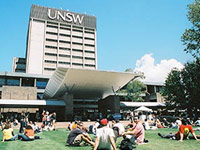|
|||||||||||
| Remote Sensing | |||||||||||

Remote sensing is the development and interpretation of digital spatial data from high-resolution satellites and airborne imagery systems to monitor and analyse changes in the surface features of the Earth.
Remote sensing aims to provide students with the knowledge and skills needed for a theoretical basis in spatial phenomena and an understanding of data processing and analysis techniques. Remote sensing provides a unique source of information for various social, environmental, oceanographic and military applications and graduates with a background in remote sensing may find employment in forestry, agriculture, natural resource management, wildlife conservation, environmental change, pedology, oceanography, geology, meteorology, and politics. Studying Remote Sensing at UNSW Remote Sensing may be studied as part of a Geography major in the Bachelor of Science degree program and in degree programs in other faculties, such as the Faculty of Arts. It can also be studied as part of the Bachelor of Engineering in Surveying and Spatial Information Systems with in the Faculty of Engineering. Please refer to the table below for a complete list.
Remote Sensing can be studied as
|
|||||||||||



